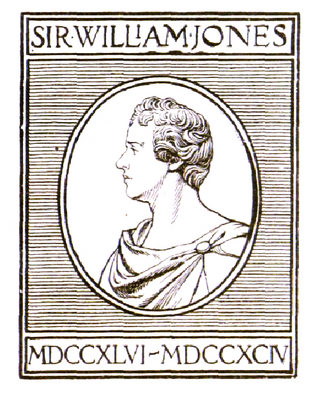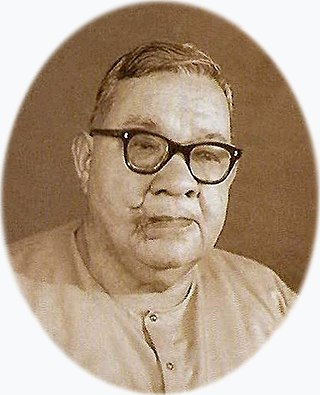
Ram Mohan Roy was an Indian reformer and writer who was one of the founders of the Brahmo Sabha in 1828, the precursor of the Brahmo Samaj, a socio-religious reform movement in the Indian subcontinent. He has been dubbed the "Father of Indian Renaissance." He was given the title of Raja by Mughal emperor Akbar II.

Presidency University(formerly Presidency College) is a public state university located in College Street, Kolkata. The institution was elevated to university status in 2010 after functioning as a constituent college of the University of Calcutta. Founded in 1817, it is one of the oldest places of higher education in India. Alumni of Presidency University include two Nobel laureates, leaders of the Indian Independence Movement, heads of state, Academy Award winners and pioneers in Bengali art and literature.

The Asiatic Society is an organisation founded during the Company rule in India to enhance and further the cause of "Oriental research". It was founded by the philologist William Jones on 15 January 1784 in a meeting presided over by Justice Robert Chambers in Calcutta, the then-capital of the Presidency of Fort William.

The Bengal Presidency, officially the Presidency of Fort William in Bengal, later the Bengal Province, was the largest of all three presidencies of British India during Company rule and later a province of India. At the height of its territorial jurisdiction, it covered large parts of what is now South Asia and Southeast Asia. Bengal proper covered the ethno-linguistic region of Bengal. Calcutta, the city which grew around Fort William, was the capital of the Bengal Presidency. For many years, the governor of Bengal was concurrently the governor-general of India and Calcutta was the capital of India until 1911.

Ishwar Chandra Bandyopadhyay, popularly known as Ishwar Chandra Vidyasagar, was an Indian educator and social reformer of the nineteenth century. His efforts to simplify and modernise Bengali prose were significant. He also rationalised and simplified the Bengali alphabet and type, which had remained unchanged since Charles Wilkins and Panchanan Karmakar had cut the first (wooden) Bengali type in 1780.

The Bengal Renaissance, also known as the Bengali Renaissance, was a cultural, social, intellectual, and artistic movement that took place in the Bengal region of the British Raj, from the late 18th century to the early 20th century. Historians have traced the beginnings of the movement to the victory of the British East India Company at the 1757 Battle of Plassey, as well as the works of reformer Raja Rammohan Roy, considered the "Father of the Indian Renaissance," born in 1772. Nitish Sengupta stated that the movement "can be said to have … ended with Rabindranath Tagore," Asia's first Nobel laureate.

Sukumar Sen was an Indian linguist and historian of the Bengali literature, who was also well versed in Pāli, Prakrit and Sanskrit.

David Hare was a Scottish watchmaker, philanthropist, and educationist in Bengal, India. He founded many educational institutions in Calcutta, such as the Hindu School, and Hare School and helped in founding Presidency College.
Fort William College was an academy of oriental studies and a centre of learning, founded on 18 August 1800 by Lord Wellesley, then Governor-General of British India, located within the Fort William complex in Calcutta. Wellesley started the Fort William College with the original intention that it would serve as a training ground for future European administrators. He backdated the statute of foundation to 4 May 1800, to commemorate the first anniversary of his victory over Tipu Sultan at Seringapatam. Thousands of books were translated from Sanskrit, Arabic, Persian, Bengali, Hindi, and Urdu into English at this institution.

Hindu School is a state government-administered school in Kolkata (Calcutta), India. Founded in 1817, it is the oldest modern educational institution in Asia. The institution played a key role during Bengal Renaissance period. It is located on College Street, in the vicinity of Hare School, College Square, Presidency University, Sanskrit College, Calcutta Medical College and the University of Calcutta.

Peary Chand Mitra was an Indian writer, journalist, cultural activist and entrepreneur. His pseudonym was Tek Chand Thakur. He was a member of Henry Derozio's Young Bengal group, who played a leading role in the Bengal renaissance with the introduction of simple Bengali prose. His Alaler Gharer Dulal pioneered the novel in the Bengali language, leading to a tradition taken up by Bankim Chandra Chatterjee and others. Mitra died on 23 November 1883 in Kolkata.
Gangadhar Bhattacharya was an Indian editor and printer, and pioneer of Bengali print and journalism. He was born in Bahar village, near Serampore, Bengal. He started his career as a compositor at the Serampore Mission Press, later moving to Calcutta, where he first worked at the Ferris and Company Press before setting up his own, the Bengali Printing Press, along with his business partner, Harishchandra Ray.

Bhudev Mukhopadhyay (1827–1894) was a writer and intellectual in 19th century Bengal. His works were considered ardent displays of nationalism and philosophy in the period of the Bengal renaissance. His novel Anguriya Binimoy (1857) was the first historical novel written in Bengal.

Raja Rajendralal Mitra was among the first Indian cultural researchers and historians writing in English. A polymath and the first Indian president of the Asiatic Society of Bengal, he was a pioneering figure in the Bengali Renaissance. Mitra belonged to a respected family of Bengal writers. After studying by himself, he was hired in 1846 as a librarian in the Asiatic Society of Bengal, for which he then worked throughout his life as second secretary, vice president, and finally the first native president in 1885. Mitra published a number of Sanskrit and English texts in the Bibliotheca Indica series, as well as major scholarly works including The antiquities of Orissa, Bodh Gaya (1878), Indo-Aryans and more.

Ramkamal Sen (1783–1844) was the Diwan of the Treasury, Treasurer of the Bank of Bengal and Secretary of the Asiatic Society, Calcutta.

Pandit Madhusudan Gupta was a Bengali Baidya Brahmin translator and Ayurvedic practitioner who was also trained in Western medicine and is credited with having performed India's first human dissection at Calcutta Medical College (CMC) in 1836, almost 3,000 years after Susruta.
Raja Sir Radhakanta Deb Bahadur KCSI was a scholar and a leader of the Calcutta conservative Hindu society, son of Gopimohan Deb of Shovabazar Raj who was the adopted son and heir of Maharaja Nabakrishna Deb of Shovabazar Raj.
In the last quarter of the 18th century, Calcutta grew into the first major centre of commercial and government printing. For the first time in the context of South Asia it becomes possible to talk of a nascent book trade which was full-fledged and included the operations of printers, binders, subscription publishing and libraries.
Bhabani Charan Bandyopadhyay was a noted Indian journalist, author and an orator. He was a conservative Hindu, who opposed Ram Mohan Roy in the abolition of Sati System. He was the founder of the Dharma Sabha. After his death, a work on his life and history (Jeebancharit) was published in 1849 under the custody of his son, Raj Krishna Bandyopadhyay, the then Secretary of the Dharma Sabha.

Rasamay Dutt or Russomoy Dutt was a Bengali educationist of British India during the Bengali Renaissance. He was the co-founder of Hindu School, Kolkata. Bengali poet Toru Dutt was his granddaughter.













